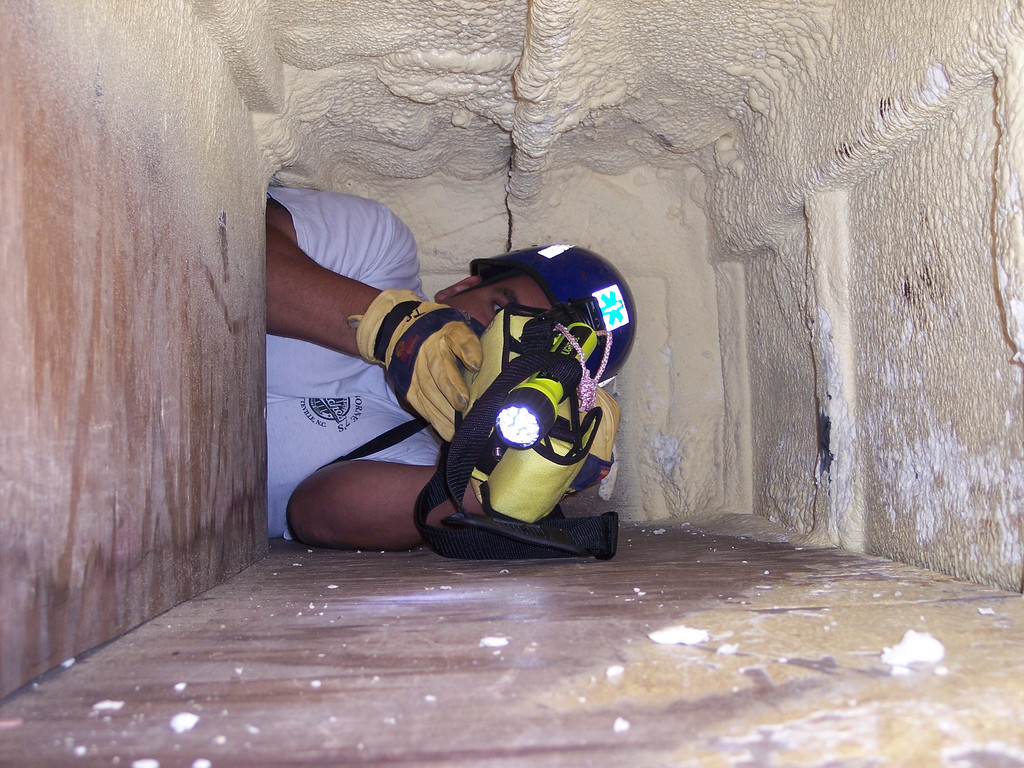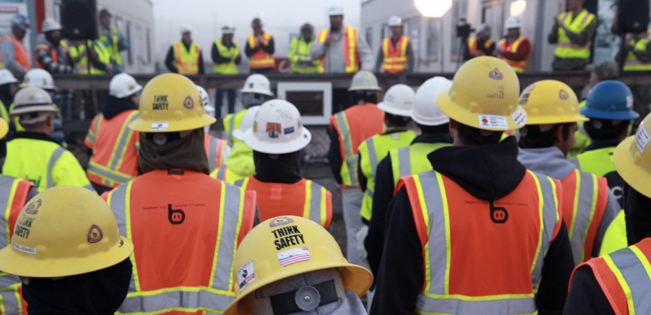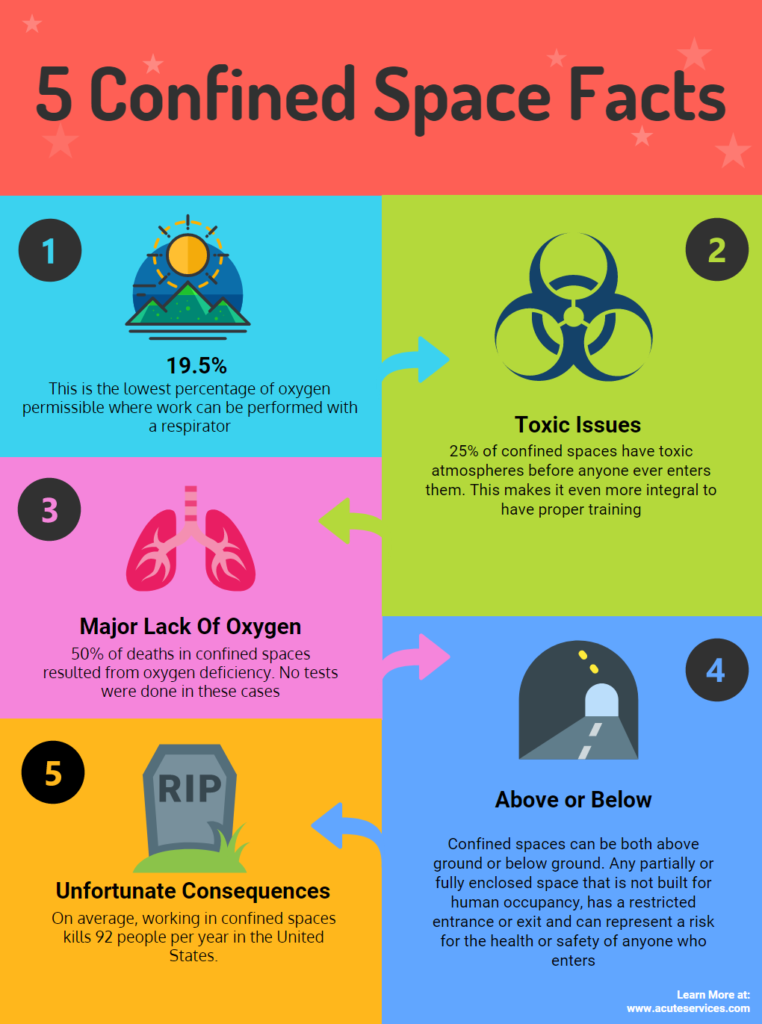Confined space training is essential for everyone who will face such working conditions. These tight areas are high-risk workspaces that have caused the death of workers and would-be rescuers. Contact the experienced professionals at ACUTE Environmental and Safety Service to get you trained and keep you safe on the job.
Examples of confined spaces include tanks, vessels, silos, storage bins, hoppers, vaults, pits, manholes, tunnels, equipment housings, ductwork, and pipelines.
Not surprisingly, very specific regulations need to be followed by workers who work in and around these spaces.
It’s important, therefore, to recognize the hazards associated with confined spaces, and to be able to safely perform the assigned duties for that specific confined space.
Looking For Confined Space Training Now?

Who Needs Confined Space Training?
According to the Ontario Ministry of Labour, Immigration, Training and Skills Development, “Every worker who works in a confined space must receive adequate training in the recognition of hazards associated with confined spaces and training to be able to safely perform the assigned duties for that specific confined space. Training is also required for persons contributing to the work activity (i.e., performs related work) even those not entering the confined space, for example, attendants and rescue workers.”
Additionally, “Giving instructions to a confined space worker does not ensure that the worker is competent to safely perform work. Hands-on training should be an essential part of the confined space training. In cases where a worker is new to the job and does not have sufficient experience, one effective means of ensuring the new worker obtains adequate experience and training would be to have the worker teamed up with more experienced workers.”
What Is Involved In Confined Space Training?
Confined space training includes, but is not limited to, the following:
- Recognition and identification of potential hazards associated with the confined spaces that will be entered.
- Evaluation and control procedures for the identified or potential hazards.
- Familiarity with all equipment such as ventilation equipment (blowers), harnesses, and air quality monitors (e.g., Oxygen/combustible meters) that will be used while in the confined space.
- Familiarity with all personal protective equipment (e.g., respirators) that the worker will be using while in the confined space.
- Procedures for entering the confined space.
- Procedures to follow in the event of a situation developing that could present additional risk to the worker or an emergency.
- The specific work to be done while in the confined space.

Where Does Confined Space Training Take Place?
Confined space training consists of two general elements: classroom lectures and discussion, as well as a hands-on practical component.
With ACUTE Services, for example, you will experience classroom interaction with experienced instructors, perform hazard assessments and apply appropriate control measures, witness demonstrations and hands-on training in the inspection, care, and use of personal protective and rescue equipment, and receive detailed handouts, videos, and quizzes.
All confined space training, then, should include a balance of classroom learning and in-the-field action, meaning it will need to be done at an appropriate safety training center that offers the following:
- Industry standard health and safety equipment and technologies
- Simulation areas for a full suite of training programs (i.e. working at heights, confined space, and hazardous materials)
- Classroom facilities for lecture and technical training delivery
- Human dummies for confined space rescue and hazardous material controls.
Consult ACUTE’s training course calendar to pick a date that works best for you.

Why Is It Important?
There are four main dangers in confined spaces:
- oxygen deficiency and oxygen enrichment
- fire and/or explosion
- toxicity
- drowning in liquids and/or entrapment in free-flowing solids
Per the Government of Canada, “investigation reports show that accidents are caused when people are not well trained or fully informed about the hazards of entering confined spaces. Accident statistics suggest that about 50 percent of deaths in confined spaces have resulted from oxygen deficiency and that no testing was done in those cases.”
Workers need to know that when the confined space can’t be tested or ventilated, they don’t have breathing apparatus, and they don’t have an entry procedure, they should not enter.
Without the proper training, these steps may be missed, leading to catastrophic results.
Here’s a few more important things to know about the importance of confined space training:

Why Choose ACUTE Services For Confined Space Training?
ACUTE’s training program will familiarize a participant with the requirements of Ontario Regulation 632/05 – Confined Spaces.
Furthermore, the training program is intended to provide entrants, attendants, and competent persons the skills and training required to recognize confined space entry risks and how to establish measured and corresponding controls.
Participants will have the opportunity to become familiar with, inspect, and use Confined Space Entry (CSE) access equipment and air quality instrumentation.
Training program topics include:
- Confined space entry accidents
- Regulation 632/05 – Confined Spaces overview
- Statutory and regulatory responsibilities
- Confined space documents
- Recognizing confined space entry hazards
- Assessing risk
- Controlling hazards
- Evaluating control measures
- Air quality monitoring
- Ventilation and purging
- Lock-out/Tag-out
- Rescue planning
ACUTE – Helping You Work Safe!
Here are just a few things you can expect when training with ACUTE:

- Open Door Instructor-Student Partnership – ACUTE’s training services emphasize client participation. Staff want to build relationships with clients and serve as a touchstone for advice anytime moving forward.
- Serving Your Team and Industry – With a vast array of clients in manufacturing, construction, health, academic, and government agencies, ACUTE brings the best safety practices from across the spectrum to your workplace.
- 100 Years Combined Experience – ACUTE provides comprehensive health and safety training, on-site safety services, and consulting services. With over 100 years of combined experience, our staff offer more than theoretical or abstract ideas. ACUTE offers solutions.
- Track Record of Success – ACUTE is rated 4.9/5 stars on Google reviews, demonstrating a commitment to our clients, quality, and passion for training.
“We have relied on ACUTE for years to train our staff and keep them safe on the job site.”
– Bob, Millwrighting Company
ACUTE is located in Waterloo, Ontario and services customers from the cities such as Toronto, Mississauga, Brampton, Hamilton, Milton, Kitchener, London, Guelph, and other cities from across Ontario.


